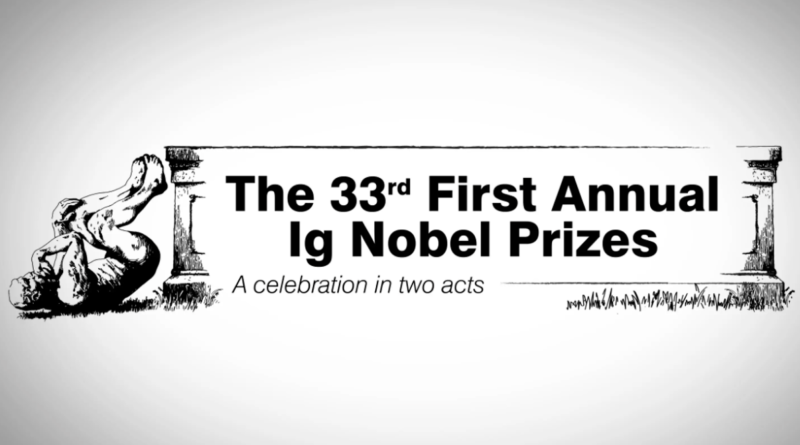Licking rocks and speaking backwards: the weirder side of science

They might not be as famous as the “real” Nobels but we all look forward to them.
First, they make you laugh and then they make you think. The Ig Nobel Prizes celebrate the unusual and honor the imaginative — raising people’s interest in science, medicine, and technology. Every September, these awards are given to scientists from around the world, who have to explain their findings first in 24 seconds and then in seven seconds.
This year’s ceremony, which was webcast live, introduced ten new Ig Nobel Prize winners who have advanced humanity’s knowledge on some big questions, such as “do we need toilets that analyze our excreta and identify us by taking photos of our anuses?" and “how much do horny anchovies influence ocean water mixing.”
The winners included scientists, doctors, economists and mathematicians from many countries, who received a counterfeit Zimbabwean $10 trillion note as a prize. They were presented by genuinely bemused Nobel Laureates, such as Frances Arnold (chemistry, 2018), Jerry Friedman (physics, 1990) and Marty Chalfie (chemistry, 2008).
This year’s winners
Jan Zalasiewicz, a paleontologist at the University of Leicester in the UK, won the chemistry and geology Ig Nobel prize for explaining why many scientists like to lick rocks in the paper “Eating Fossils.” He explained the fascinating history of the rock-licking practice, a way to test if a rock is actually a rock or instead a piece of a fossilized bone.
The literature prize went to a group of researchers, Chris Moulin, Nicole Bell, Merita Turunen, Arina Baharin, and Akira O’Connor, for studying the sensations people feel when they repeat a single word many times. They looked at the concept of jamais vu, a strange sensation of novelty related to something the person has seen or experienced before.
Te Faye Yap, Zhen Liu, Anoop Rajappan, Trevor Shimokusu, and Daniel Preston won the mechanical engineering Ig Nobel for re-animating dead spiders to use as mechanical gripping tools. They transformed a dead wolf spider into a gripping tool with a single assembly step, launching a new research field that they have called “necrobotics.”
Seung-min Park, a urology instructor at Stanford University, won the public health prize for inventing the Stanford Toilet, a very intriguing device. It uses a mix of technologies, such as an anal-print sensor paired with a camera and a urinalysis dipstick test strip, among others, to monitor and analyze in minutes the substances that humans excrete.
The physics prize went to researchers Bieito Fernández Castro, Marian Peña, Enrique Nogueira, Miguel Gilcoto, Esperanza Broullón, Antonio Comesaña, Damien Bouffard, Alberto C. Naveira Garabato, and Beatriz Mouriño-Carballido. They measured the
extent to which ocean-water mixing is affected by the sexual activity of anchovies.
María José Torres-Prioris, Diana López-Barroso, Estela Càmara, Sol Fittipaldi, Lucas Sedeño, Agustín Ibáñez, Marcelo Berthier, and Adolfo García won the communications prize for studying the mental activities of people who are expert at speaking backwards. They recruited backward speakers for their experiments, both native Spanish speakers.
The medicine prize went to Christine Pham, Bobak Hedayati, Kiana Hashemi, Ella Csuka, Tiana Mamaghani, Margit Juhasz, Jamie Wikenheiser, and Natasha Mesinkovska. They used cadavers to explore whether there is an equal number of hairs in each of a person’s nostrils.
Homei Miyashita and Hiromi Nakamura won the nutrition prize for looking at how electrified chopsticks and drinking straws can change the taste of food. Stanley Milgram, Leonard Bickman, and Lawrence Berkowitz got the psychology prize for experiments to see how people stop to look upward when they see others doing the same.
Finally, the education Ig Nobel went to researchers Katy Tam, Cyanea Poon, Victoria Hui, Wijnand van Tilburg, Christy Wong, Vivian Kwong, Gigi Yuen, and Christian Chan. They studied whether a teacher’s boredom could influence how bored students become in class and how this affects their overall motivation to learn in class.
No joke
The Ig Nobel Prizes, while humorous and entertaining, have deeper significance in the world of science and research. Many scientific breakthroughs have come from unusual and unexpected experiments. The Ig Nobel Prizes honor that spirit of curiosity, showing that sometimes what seems silly or odd can lead to meaningful insights. Also, by bringing humor into the mix, the Ig Nobel Prizes make science more approachable and relatable for the general public.
This can help bridge the gap between scientists and non-scientists, fostering a broader appreciation for research. Essentially, the Ig Nobel Prizes have a lighthearted facade, but they play a meaningful role in celebrating the quirkier side of scientific inquiry and reminding us all of the breadth, depth, and unpredictability of research.
Notably, physicist André Geim was awarded both the Ig Nobel and the Nobel Prize -- in that order. In 2000, Geim won the Ig Nobel Prize in Physics for using magnets to levitate a frog. This was a fun demonstration of the magnetic properties of water and living tissues. A decade later, Geim was awarded the Nobel Prize in Physics, shared with Konstantin Novoselov, for their groundbreaking experiments with graphene, a one-atom-thick layer of carbon atoms. Graphene has since become a hot topic in material science.
This year, there will be a new event after the award ceremony called Nobel Face-to-Face where winners and other researchers will ask each other questions about their work. The event is scheduled for October 14, and it will be hosted in Sanders Theatre at Harvard University. Further information will be announced on the Ig Nobel website.
Image credits: Ig Nobel Awards
Edited and reviewed by Zoe Gordon





